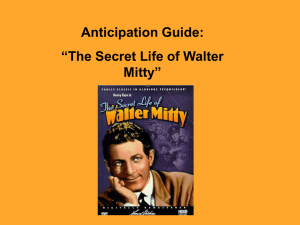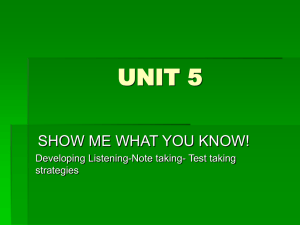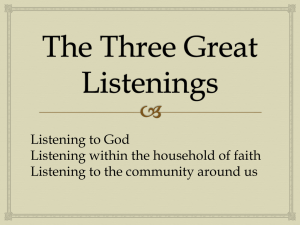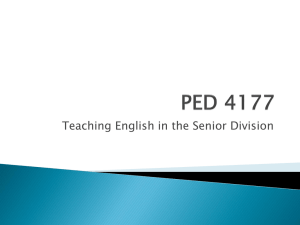Establishing a Culture of Talk
advertisement
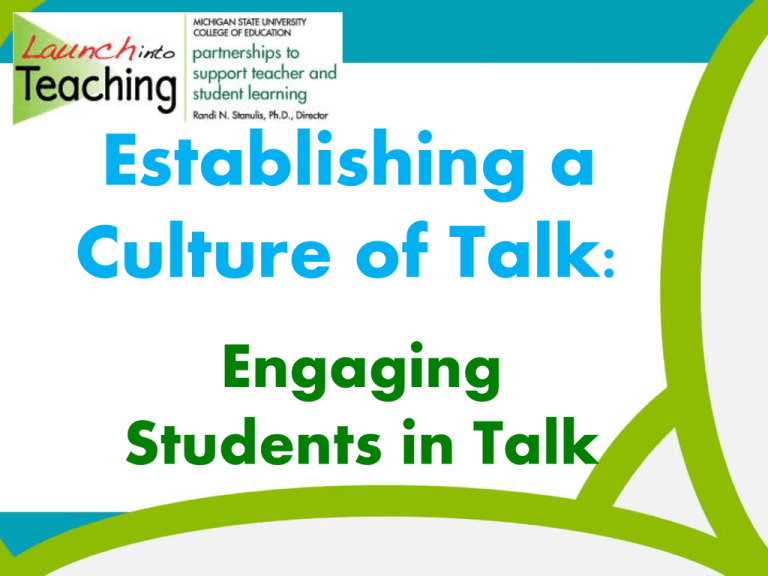
Establishing a Culture of Talk: Engaging Students in Talk A Rigorous Discussion is about… • Asking questions and posing problems • Voicing ideas using evidence • Listening to others • Monitoring for rigor • Responding to different ideas • Constructing understanding During the first weeks of school, norms and procedures need to be established to create a culture for talk. These norms and procedures need to be posted and revisited often. Provide students with opportunities to practice the types of rigorous discussions in which you expect them to engage. Begin slowly… Like *Creating a culture of talk anything can begin with partners, groups, or the whole new that we small group. learn, *The first discussions in your classroom should discussions emphasize the discussion process, rather than the need to be content. modeled and *Debrief to determine what worked/didn’t practiced! work in the discussion. What are some ways to model and practice norms and procedures? Select a topic for the students to discuss: *Ask two students to model a “partner share” using the established norms and procedures. *Practice active listening by asking one student to summarize what another student said. *Ask a group of students to “fishbowl” a discussion, stopping frequently to talk with the rest of the class about what they see and hear. After modeling or practicing has occurred, ask the class what they noticed about the discussion process. This helps students think beyond the topic to how a rigorous discussion occurs. The students are familiar with the norms and procedures we’ve developed for classroom discussions. How do I share my expectations for talk in the classroom? Pose a problem around content – a math concept, a dilemma posed in a piece of literature, a hypothesis… When a few students raise their hands to respond, the teacher can send a message about the kind of classroom culture and the kind of learning that’s going to occur in the class by responding with something like: “ I see Akira has her hand up with an idea and I see that Melea and Jose have ideas. Tyrell has an idea and Corine has an idea. I want to hear all of your ideas but I want you to remember that it’s not just me you’re sharing with; it’s everyone in the class. So, speak up so everyone can hear your idea. If you don’t have your hand up, your job is to listen to the ideas your classmates are sharing and decide if you agree or disagree with what they are saying. “ How do I help my students develop effective discussion skills? Turn and Talk strategy is useful when lots of students have ideas to share. The teacher says: “Turn to your neighbor/partner and tell them what your thoughts are about….” The teacher then asks one member of the pair to summarize the discussion they had. Or, when active listening skills are to be reinforced, the teacher might ask a member of the pair to relate what their partner said to them. Journal Jot is a strategy teachers use when they want to give students an opportunity to collect and write their thoughts before sharing them out with the class. The teacher says: “Take a few minutes to write your thoughts about….” When students have completed their writing, the teacher asks them to share it with partners, small groups, or the whole class and invites students to respond to one another. Value Line Up is a strategy used by teachers when they want students to appreciate the differing views people have around a variety of topics/issues. The teacher says: “I’d like you to form a line across the front of the classroom. If you strongly agree, stand near this end of the line based on how strong your belief is. If you disagree, do the same at the opposite end of the line.” The teacher can then invite individuals share their view with the class and ask participants to change their location on the line as their views shift on this issue. Or, the teacher can “fold” the line in half, and invite participants to share their views with someone with an opposite view. This helps develop active listening skills. Choose A Side is similar to Value Line Up. But, in this case, the teacher simply asks students to choose a side of the room to sit on that coincides with their beliefs about a rigorous topic or problem. During the ensuing discussion, students are invited to move to the other side of the room if a point made during the discussion sways their view. Pass the Hat is a strategy teachers use to encourage students who might otherwise be hesitant to ask questions they have about complex ideas to pose these to the class. The teacher says: “I’m passing a hat around the room. Place questions you would like the class to address in the hat.” The teacher then selects questions from the hat to use in launching and maintaining the discussion asking students for evidence from the rigorous text/problem to support their thinking. Bell Ringers are often used by teachers as warm up activities. At the beginning of the class, the teacher posts an open-ended question/ problem on the blackboard for students to work on independently and then talk with a partner/small group about. This talk is a way to launch the lesson; students engage in critical thinking around a concept they will be working with during the day’s learning. The teacher asks students to share ideas with the class, noting evidence of prior knowledge, connections, or misconceptions to adapt the lesson as needed. Role Play is a way to provide practice for behaviors the teacher wants the class to engage in. Sometimes this is done “fishbowl” style with a group of students acting out a strategy, norm. or procedure in front of the class with the teacher stopping the action frequently to talk about what the class is seeing/hearing. At other times, the teacher might ask small groups or pairs to practice a behavior simultaneously, stopping along the way or debriefing afterwards to determine what worked/didn’t work and make adaptations as needed. Additional strategies teachers use in promoting talk in the classroom are available by contacting us at: launch.msu.edu How do I ensure that students are respectful while disagreeing? Disagreements and inappropriate responses are opportunities for teaching. Talk about these matter-of-factly: “Jamal, you rolled your eyes, sighed loudly, and said ’That’s dumb’ when Rosa said she thinks that sometimes slavery can be a good thing. I’m glad you were listening and reacting to what was being said. But I’m wondering if we need to add to our norms and develop some ways we can respectfully disagree with one another. Instead of grunting, rolling eyes, or yelling something like ‘That’s dumb’ which might shut someone down who has very good ideas but having difficulty expressing them (or someone who really is wrong who might benefit from hearing your divergent ideas), how could we handle differences of opinions?” What makes this an opportunity for learning? The teacher can accept student ideas and “give them a try” for a few days, directing students who disagree to use the protocol developed by the class. The teacher might model the type of interactions they are hoping for the students to engage in. The teacher can encourage the student who disagrees to restate the other student’s idea, ask that student if the interpretation is correct, and then offer their own idea with evidence to back it up: Jamal: “Rosa, I think I heard you say that there are situations where slavery is okay. Is that correct?” Rosa: “Yes, in situations where someone has no means of supporting themselves, no skills to get their own job because they’re in a foreign culture where they don’t know the native language… Jamal: “Well, I’m thinking that slavery is always wrong because they wouldn’t be in that foreign culture if someone hadn’t taken them against their will in the first place. On page 64 of the book it said that the kids had been torn from their mother’s arms and left to fend for themselves as she was thrown on a ship.” The students gain a better understanding of one another’s point of view while learning important social communication skills. How can I make talk equitable in the classroom? Not all students are comfortable sharing their ideas in a public forum. You need to decide if it’s okay for them to be engaged through just listening. They might later share their understandings one on one or in writing. Some teachers… *Call on students with hands up *Pull sticks with names on *Write names on a sheet of paper, as students raise hands, acknowledging with a nod that they wrote the name down. This frees the student to lower their hand and listen until the teacher calls on them. Students learn to jot ideas down so they don’t forget them. When called on, they say something like “I want to respond to what Carlos said a few minutes ago about ….” Or, “I was going to make a point about….. but Alex already did.” Are there tools the students can use independently to make talk equitable? Some teachers: • Provide two sided chips for students to flip; green means “I have something to contribute” and red means “I’m listening and processing what is being said”. • Give students two-sided paddles to hold up with agree/disagree sides, smiley/confused faces, or question/connection for students to raise in indicating their participation. • Use speaker props – a ball or microphone for the speaker to hold; once students are ready to begin the discussion, the group is called to order when the teacher takes out the “discussion prop.” Once the discussion begins, only the person with the prop may speak. How do I encourage students to develop their ideas? Prepare Ahead of Time: Developing open-ended, higher level questions before the discussion helps to develop critical thinking skills. Bloom’s Taxonomy is a great resource to learn how to write questions. Assigning a reading, math problem, or science experiment before the discussion and telling the students they’ll be expected to share their understandings with one another helps them come prepared with their ideas in their heads or jotted down . Learning how to “press” students to explain or develop their ideas helps to deepen their understanding. What do you mean by “press”? Teacher Press Examples: Teacher Press refers to really listening to your students’ responses and asking them to “tell me more” or “give an example” or “say it another way” when their ideas are unclear or need further development. New questions often stem from these exchanges. These also serve as places where students often agree/disagree with one another while deepening content knowledge. • In what ways could you apply this learning to a new situation? • Can you tell me more about…? • How will you/did you figure out ….? • Can you help me to see how this is different/the same as… ? • I’m fascinated by …. Tell me more. • What do you mean when you say ….? • How can you help us understand what you are thinking? • Can you think of another way you might…? • What are the important ideas or processes involved in this problem? Research shows a link between engaging students in talking about their learning through classroom discussions and higher student achievement. Teachers can impact student test scores while deepening content knowledge. For more information on Launch into Teaching, contact us at: Launch into Teaching 303 Erickson Hall East Lansing, Michigan 48824-1034 517-353-9135 launch@msu.edu


